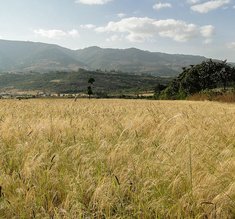|
Description
|
Term
|
|
That which when of limited quality or quantity can harm development by impeding trade and thus the earning of foreign exchange, increasing geographic immobility, and deterring foreign direct investment
|
Infrastructure
|
|
A process of transforming an economy by expanding manufacturing and other industrial activity
|
Industrialisation
|
|
That the growth of which governments try to limit by; fining couples who have more than a certain number of children and giving financial incentives to have fewer children (though this can cause infanticide and child trading, particularly of girls), or providing contraceptives, a welfare system that reduces the incentive to have more children, or by better education women and girls
|
Population
|
|
Banking according to the provisos of Sharia Law, not charging interest but making profit instead through equity participation, sharing the profits of projects it loans money to
|
Islamic Banking
|
|
The expansion of people's freedom to live long, healthy, and creative lives, to advance goals they value, and to engage actively in shaping development equitably and sustainable on a shared planet
|
Human Development
|
|
That which largely determines the size of the multiplier effect
|
Marginal Propensity to Withdraw
|
|
Those governments most affected by inexperience and vanity - harmful to development due to inefficiency and diversion of money to vanity projects - such as the government of Jean-Bédel Bokassa declaring himself emperor of Central Africa and spending over a twelfth of the country's GDP on his Napoleonic style coronation
|
Post-Colonial Government
|
|
That which may harm development if a rise in output is achieved via longer working hours and more pollution, as well as a fall in life expectancy or a reduction in human rights
|
Economic Growth
|
|
That the benefit of which to less developed countries is that it creates employment due to being labour intensive, has income-elastic demand, brings in export revenue, makes use of a country's natural resources and increases demand for transport and locally produced goods
|
Tourism
|
|
That which high taxes may decrease as they would decrease demand for sterling
|
Exchange Rate
|
|
|
Description
|
Term
|
|
Institutions that accept deposits from a range of small depositors and make long-term loans for house purchase, with the property acting as collateral on the debt, many having now rebranded as retail banks
|
Building Societies
|
|
A measure of the amount of money counting only notes and coins in circulation and commercial banks' deposits at the Bank of England, all being perfectly liquid and held for transaction purposes, though no longer used since the rise of electronic payment
|
Narrow Money (M0)
|
|
That the affects of which on development is most determined by the way it is achieved, how the benefits are shares, and the extent to which it is accompanies by costs
|
Economic Growth
|
|
Those objectives of the government the principal examples of which are to ensure international competitiveness, an acceptable distribution of income and wealth, and to achieve sustainable economic growth in part by maintaining economic stability
|
Macroeconomic Objectives
|
|
That measure which is criticised as a measure of development as it doesn't take into account the informal economy (50.2% of total employment in Ethiopia in 1999) or income distribution and inequality
|
GNI per Capita (PPP$)
|
|
That economic model criticised for not taking into account a lack of job vacancies, occupational immobility, negative externalities caused by rapid urbanisation, or a lack of reinvestment (repatriation of profits, etc.) while also encouraging the neglect of the rural sector by governments, causing stagnating productivity and increasing rural-urban inequality
|
Lewis Two-Sector Model
|
|
A model of how real goods and services, and money flows in the economy, there being long-term equilibrium whereby withdrawals (W) = injections (J)
|
Circular Flow of Income
|
|
That the three types of which are progressive (taking a higher percentage from those with higher incomes), proportional (taking the same percentage from all), and regressive (taking a higher percentage from those with lower incomes)
|
Tax
|
|
That the size of which is most affected by the amount spent by government in relation to income such as due to electoral promises or policy commitments, policy decisions (public sector wage increases, infrastructure investment, etc.) and unavoidable increased in transfer payments
|
Fiscal Deficit
|
|
Those the cutting of which could actually increase unemployment as they would not increase the jobs available if unemployment is cyclical and thus would cause the unemployed to consume less, reducing aggregate demand, and causing more unemployment
|
Unemployment Benefits
|
|

